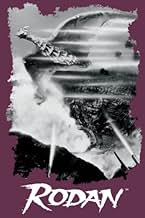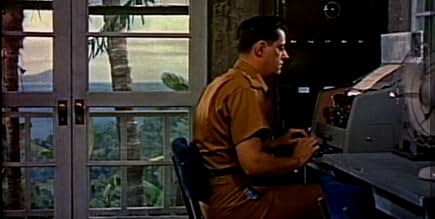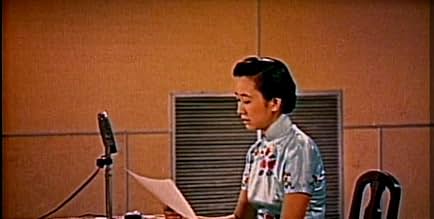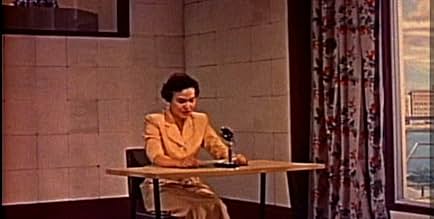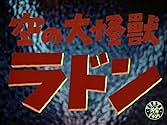ÉVALUATION IMDb
6,2/10
6,5 k
MA NOTE
Ajouter une intrigue dans votre langueA mining engineer investigates the deaths of his colleagues, discovering prehistoric nymphs and a creature capable of flying - and wreaking havoc - at supersonic speeds.A mining engineer investigates the deaths of his colleagues, discovering prehistoric nymphs and a creature capable of flying - and wreaking havoc - at supersonic speeds.A mining engineer investigates the deaths of his colleagues, discovering prehistoric nymphs and a creature capable of flying - and wreaking havoc - at supersonic speeds.
Kenji Sahara
- Shigeru Kawamura, colliery engineer
- (as Kenji Sawara)
Kiyoharu Onaka
- Male Honeymooner, Sunagawa's friend
- (as Kiyoharu Ohnaka)
Mike Danning
- American Soldier Typing
- (as Mike Daneen)
Tsurue Ichimanji
- Haru, Kiyo's neighbor
- (as Tazue Ichimanji)
Avis en vedette
This film is one of the best of the kaiju eigas that Toho ever made. The reason for this is that it is played much like the movie that in a way inspired it, "Them". The way the film begins plays almost like them did, the police and mine workers wondering who, or what, is responsible for the deaths of four men. The tension builds and builds from the first appearance of the giant insects to the destruction of Fukuoka (for some reason called Sasebo in the American version). Even though Rodan the monster did not become as successful as Godzilla, the film is more of a thrill ride and definitely should be hailed as a great science fiction film.
So the other night I watched a film that I had not seen more than once since I was a kid, the 1956 Japanese classic "Rodan." I had seen this movie at NYC's Film Forum around 25+ years back but had very little recollection of it still. And what a fun film it is, as I was reminded again just recently. In it, miners in a small Japanese village are being killed off by a mysterious something, and that something turns out to be giant bugs that have hatched deep underground. But the community's problems grow even worse when two prehistoric eggs in the mine shaft suddenly burst open, to reveal two monstrous flying reptile creatures, which promptly do what all self-respecting Japanese kaiju do in situations like this: lay waste to the countryside and a neighboring city! This film was helmed by "Gojira" director Ishiro Honda, of course, and like that earlier film, features awesome FX by the great Eija Tsuburaya and music by Akira Ifukube. The FX range from cheesy (the two rodans look pretty silly) to spectacular (one of the bridges that gets destroyed looks so lifelike that I would swear the producers knocked down an actual bridge in the making of this film). The film's final image, of the two rodans going up in flame near an erupting volcano, choosing death together rather than fighting separately, is actually kind of sweet and lovely. Adding to the fun: the presence of "Gojira"'s Dr. Serizawa himself, actor Akihiko Hirata, minus the eyepatch here. In all, very entertaining stuff, and very nice to reacquaint myself with this childhood favorite again....
Japanese miners are killed by giant prehistoric insects awakened by nuclear testing. After dealing with the bugs, the military discovers an even bigger threat has been awakened by the tests. Yup, it's Rodan, a pterodactyl-like monster that flies at super-sonic speeds. Soon another Rodan shows up and the two wreak havoc. What in the world will Japan do?
Great Japanese giant monster movie with anti-nuke message; a classic of its type. Not on the level of the original Godzilla (or Gojira, if you insist) but better than many of the cheesy sequels that came out later. It's cool that it was filmed in color. The special effects and action scenes are lots of fun. Love the music. It's a good way to pass the time.
Great Japanese giant monster movie with anti-nuke message; a classic of its type. Not on the level of the original Godzilla (or Gojira, if you insist) but better than many of the cheesy sequels that came out later. It's cool that it was filmed in color. The special effects and action scenes are lots of fun. Love the music. It's a good way to pass the time.
The first of the Toho "Dai Kaiju" series in colour and some of Eiji Tsuburaya's best special effects. Although shorn to a miserly 69 minutes of the original Japanese footage (plus nearly 4 minutes of actual H-Bomb test footage stuck to the beginning by the American distributors, The King Brothers) it is a fabulously made picture.
Coal miners discover gigantic insects, known as Meganurons in the original version, which attack the local village. As if that were not bad enough a monstrous flying reptile soon hatches from an egg which has also been unearthed. Rodan's appearance is a "good news/bad news" thing because he eats the giant insects, but he also causes more damage than they ever could have!
The King Brothers, who would also give us GORGO a few years later, saved money by simply repeating certain scenes and "flopping" the image on the screen so it would look (slightly) different. Rodan and its mate appear out of the same crater in the American version. In the original version the second Rodan appears with no explanation as the first one is destroying the city of Sasebo. The narration probably saved time and allowed them to use less of the Japanese footage but having seen the original version I prefer the visual aspects of it (the end sequence is just as poignant and memorable without any dialogue).
Lovers of dubbed movies will recognise the voices of Paul Frees and Marvin Miller doing almost every voice in the picture! Keye Luke, a former Number One Son in Charlie Chan movies, provides the voice of the hero and a teenaged George Takei (later Mr. Sulu on "Star Trek") can be heard also. Look carefully during the destruction of the city and you will notice one building, a camera company, is called "The Tsuburaya Company"!
In todays genres where every movie is over-laden with CGI people should pause long enough to watch this movie and see what could be done with miniatures, imagination, and heart. Eiji Tsuburaya really loved the genre and gave his best to every assignment but THIS will always be one of his best.
Oh and about the monsters name. It was originally RADON but a British toy company had a doll on the market with that name so when the movie went abroad they simply switched the vowels in the monster's name and Radon became Rodan.
Coal miners discover gigantic insects, known as Meganurons in the original version, which attack the local village. As if that were not bad enough a monstrous flying reptile soon hatches from an egg which has also been unearthed. Rodan's appearance is a "good news/bad news" thing because he eats the giant insects, but he also causes more damage than they ever could have!
The King Brothers, who would also give us GORGO a few years later, saved money by simply repeating certain scenes and "flopping" the image on the screen so it would look (slightly) different. Rodan and its mate appear out of the same crater in the American version. In the original version the second Rodan appears with no explanation as the first one is destroying the city of Sasebo. The narration probably saved time and allowed them to use less of the Japanese footage but having seen the original version I prefer the visual aspects of it (the end sequence is just as poignant and memorable without any dialogue).
Lovers of dubbed movies will recognise the voices of Paul Frees and Marvin Miller doing almost every voice in the picture! Keye Luke, a former Number One Son in Charlie Chan movies, provides the voice of the hero and a teenaged George Takei (later Mr. Sulu on "Star Trek") can be heard also. Look carefully during the destruction of the city and you will notice one building, a camera company, is called "The Tsuburaya Company"!
In todays genres where every movie is over-laden with CGI people should pause long enough to watch this movie and see what could be done with miniatures, imagination, and heart. Eiji Tsuburaya really loved the genre and gave his best to every assignment but THIS will always be one of his best.
Oh and about the monsters name. It was originally RADON but a British toy company had a doll on the market with that name so when the movie went abroad they simply switched the vowels in the monster's name and Radon became Rodan.
When I was in fourth grade (around 1957), I had seen ads for this movie on television. I cut out a movie ad from the newspaper, and put it on my wall. There was no way I could see the movie because we would have had to go to the big city. I was surprised when I finally viewed it late at night, many years later. It's not a bad film There is a good deal of suspense, A romantic plot. A man falsely accused of murder. And some pretty neat monsters. Now, Pterosaurs weren't all that big, not like this, but these are mutants from messing with nuclear material. The movie has a nice pacing to it. When we get to the destruction scenes, we don't feel like they just threw all that at us like they did in future films (all those Godzilla versus whatever films). There is a kinship between the monsters (a mated pair) that would be a fact in the animal kingdom. The most creative thing is that the Rodans use the hurricane force of their enormous wings to level the city. I may just watch this again.
Le saviez-vous
- AnecdotesThe cable supporting Rodan over Sasebo Bridge snapped, causing suit actor Haruo Nakajima to fall 25 feet into the water. The incident is left in the movie as the scene where Rodan dives into the water near the bridge and submerges. The cables were re-attached for the scene where Rodan lifts off out of the water, but they almost broke again because the suit became waterlogged and doubled in weight.
- GaffesThe opening title says "Rodan © COPYRIGHT MCMXXX1V TOHO CO. LTD." This 1956 film was not copyrighted in 1934.
- Citations
Professor Kyuichiro Kashiwagi (biology): Judging from a piece of its eggshell that we discovered, this one, which we've named Rodan, has a wingspan of 270 feet and weights over 100 tons.
- Générique farfeluIn the U.S. version, special effects director Eiji Tsuburaya's name is misspelled "Eiji Tsuburya."
- Autres versionsIn the original Japanese version, there is no dialogue prior to Rodan's attack on the two honeymooners. The American version later added dialogue in which the young woman was joking about her husband taking pictures of the volcano rather than her. Also, in the original version the scene plays a little longer with Rodan making a pass above the couple, with his shadow passing over them, before he swoops in to carry the couple off.
- ConnexionsEdited into Valley of the Dragons (1961)
Meilleurs choix
Connectez-vous pour évaluer et surveiller les recommandations personnalisées
- How long is Rodan?Propulsé par Alexa
Détails
Box-office
- Brut – États-Unis et Canada
- 500 000 $ US
- Fin de semaine d'ouverture – États-Unis et Canada
- 500 000 $ US
- 6 août 1957
- Durée
- 1h 22m(82 min)
- Rapport de forme
- 1.37 : 1
Contribuer à cette page
Suggérer une modification ou ajouter du contenu manquant



